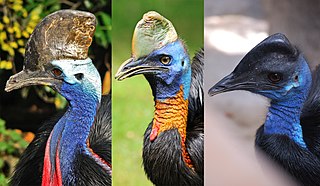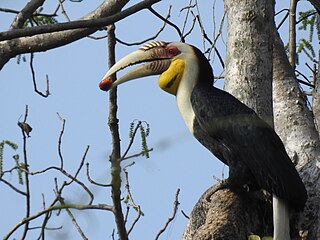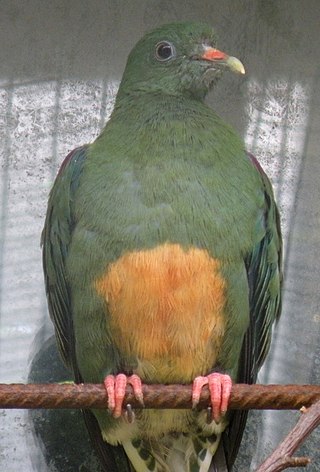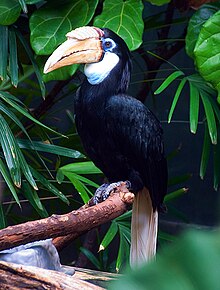
Cassowaries are flightless birds of the genus Casuarius in the order Casuariiformes. They are classified as ratites: flightless birds without a keel on their sternum bones. Cassowaries are native to the tropical forests of New Guinea, The Moluccas, and northeastern Australia.

Hornbills are birds found in tropical and subtropical Africa, Asia and Melanesia of the family Bucerotidae. They are characterized by a long, down-curved bill which is frequently brightly coloured and sometimes has a horny casque on the upper mandible. Hornbills have a two-lobed kidney. They are the only birds in which the first and second neck vertebrae are fused together; this probably provides a more stable platform for carrying the bill. The family is omnivorous, feeding on fruit and small animals. They are monogamous breeders nesting in natural cavities in trees and sometimes cliffs. A number of mainly insular species of hornbill with small ranges are threatened with extinction, mainly in Southeast Asia.

The wreathed hornbill is an Old World tropical bird of the hornbill family Bucerotidae, also called bar-pouched wreathed hornbill due to its distinctive blue-black band on its lower throat sac. It is named after its characteristic long, curved bill that develops ridges, or wreaths, on the casque of the upper mandible in adults. Males are black with a rufous crown, a white upper breast and face, and a yellow featherless throat. Females are uniformly black with a blue throat and are slightly smaller than males.

Bucerotiformes is an order of birds that contains the hornbills, ground hornbills, hoopoes and wood hoopoes. These birds were previously classified as members of Coraciiformes. The clade is distributed in Africa, Asia, Europe and Melanesia.

The grey-headed goshawk is a lightly built, medium-sized bird of prey in the family Accipitridae. This species was formerly placed in the genus Accipiter.

Gurney's eagle is a large eagle in the family Accipitridae. It is found in New Guinea and Wallacea, and is an occasional vagrant to Australia.

The collared imperial pigeon is a large pigeon native to New Guinea and adjacent islands.

The orange-bellied fruit dove is a small pigeon with mainly green plumage, distinguished by a large orange patch on the lower breast and belly, a small lilac shoulder patch, pale yellow undertail coverts, and a grey terminal band on the tail.
The Papuan spinetail, also known as the Papuan needletail, New Guinea spine-tailed swift or Papuan spine-tailed swift, is a small, stocky swift with a short, rounded tail and very fast flight. Head and upperparts glossy blue-black, white or whitish belly and undertail coverts, dark underwing with pale central stripe. The small spines at the end of the tail are not visible in flight.

The knobbed hornbill, also known as Sulawesi wrinkled hornbill, is a colourful hornbill native to Indonesia. The species is sometimes placed in the genus Aceros. The knobbed hornbill is the faunal symbol of South Sulawesi province.

The uniform swiftlet, also known as the Vanikoro swiftlet or lowland swiftlet, is a gregarious, medium-sized swiftlet with a shallowly forked tail. The colouring is dark grey-brown, darker on the upperparts with somewhat paler underparts, especially on chin and throat. This species is widespread from the Philippines through Wallacea, New Guinea and Melanesia. It forages for flying insects primarily in lowland forests and open areas. It nests in caves where it uses its sense of echolocation, rare in birds, to navigate.

The yellow-billed kingfisher(Syma torotoro) is a medium-sized tree kingfisher.

The Narcondam hornbill is a species of hornbill in the family Bucerotidae. It is endemic to the Indian island of Narcondam in the Andamans. Males and females have a distinct plumage. The Narcondam hornbill has the smallest home range out of all the species of Asian hornbills.

Streptocitta is a genus of large starlings in the family Sturnidae. Both species have a pied plumage and a long tail, giving them a superficial resemblance to a magpie. Although not closely related to the true magpies, they have therefore been referred to as magpies in the past. The two species are restricted to forests in Wallacea in Asia.

The blue-and-white kingfisher is a species of bird in the family Alcedinidae. It is endemic to North Maluku in Indonesia. It can be found on the islands of Morotai, Ngelengele, Halmahera, Damar, Ternate, Tidore, Moti, Bacan, Obi and Obilatu.

The white-bellied cuckooshrike is a species of bird in the family Campephagidae. It is found in Australia, the Moluccas, New Guinea and the Solomon Islands.

The hooded butcherbird is a species of passerine bird in the family Artamidae. It is found in New Guinea. Its natural habitat is subtropical or tropical moist lowland forest.

The golden monarch is a species of passerine bird in the family Monarchidae found in New Guinea. Its natural habitats are subtropical or tropical moist lowland forests and subtropical or tropical moist montane forest. The golden monarch displays marked sexual dimorphism, the male a striking golden colour with black mask, wings and tail, the female a golden or golden-olive colour. Both bear a characteristic 'teardrop' white pattern below the eye.

The black-chinned robin is a species of bird in the Australasian robin family Petroicidae. It is the only species placed in the genus Leucophantes. It is found in northern New Guinea where its natural habitat is subtropical or tropical moist lowland forests.

Rhyticeros is a genus of medium to large hornbills found in forests from Southeast Asia to the Solomons. They are sometimes included in the genus Aceros. On the other hand, most species generally placed in Aceros are sometimes moved to Rhyticeros, leaving Aceros as a monotypic genus only containing the rufous-necked hornbill.























